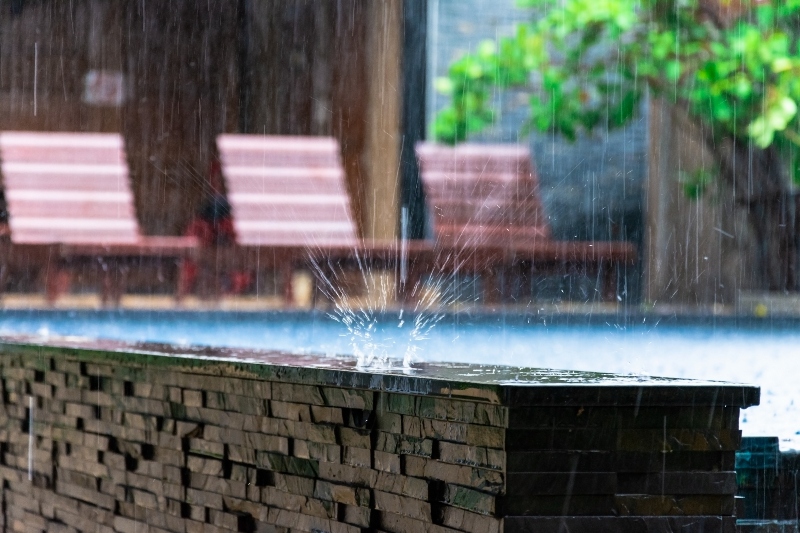
You can’t control the weather, as much as we wish it was possible! You might have asked yourself many times, does rainwater affect my pool? Rainy days are a part of life and an additional maintenance task for residential pool owners. Thankfully for the people of Texas, wet weather comes infrequently, with an average of 77 rainy days per year. Many of these downpours take place in the Spring and Fall, so if you’re looking to prepare your pool for the upcoming April showers, here is what happens when rainy days mix with backyard swimming!
The Result Of Rainwater Falling Into Your Swimming Pool
The acidic properties of rainwater can have adverse effects on the chemistry of your pool. From the pH balance and calcium hardness to alkalinity levels, wet weather can alter the chemicals working together to help keep your pool’s sanitation in sync. This can be heightened when the “run-off” water streams from gutters and decks carry dirt and debris directly into your pool, reducing the active level of chlorine found in the water.
The Interesting Properties You Will Find In Rainwater!
Rainfall takes an interesting journey before reaching your pool, bringing with it chemicals picked up from every part of its complex process. When evaporation takes place, water is removed from all its minerals and carbonations on the ground. In the clouds, it is returned in its purest form at a neutral pH level of 7, but it rarely stays that way! During a downpour, these droplets pick up contaminants in the air, such as pollutants and even the spores which create algae, which eventually mix with your pool water when the rain begins to fall.
Is Dilution An Issue For Swimming Pools During Rain Storms?
During heavy storms, owners often worry about the dilution of their pool’s chemicals which sanitize and regulate their water. In reality, an inch of rainfall can only increase an 11,000-gallon pool by around 1.5% in size, which is an unlikely culprit for any major dilution issues. This is even less of a concern in Texas, which only sees on average 25 inches of rainfall per year. However, it is important to check your levels and make changes to your pool’s functionalities during the rainy seasons and forecasts, to continue to correct chemical imbalances and rectify issues that could escalate into larger problems if left unchecked.
How To Protect Your Pool From Rain Forecasts
Reduce Water-Height When Rain Is Expected
Lowering your water to halfway past your skimmer box will help to ease the clean-up after the rain has passed, and reduce the risk of overflow. Freshwater from a downpour will usually sit on top of your pool’s water, meaning it is likely to be passed through the sanitation process controlled by your pool’s dedicated filter and skimmer equipment. You can use your pool’s pump to adjust water levels accordingly, both before and after a rainfall.
Clean Your Pool After A Downpour
Showers can come on unexpectedly, so at times you may not have the chance to prepare your pool for the upcoming forecast. After heavy rainfall, clean your pool area and remove all debris from equipment and water. The skimmer and pump baskets should also be checked to ensure no materials have been washed in, reducing water flow. Once everything is cleared and ready to go, use your filter system to start restoring your sanitization levels to normal!
Increase Your Chlorine When Rain Is Coming
Depending on how reliable your weatherman is, it can be helpful to up your pool’s chlorine intake around 1 to 2 days before a storm hits. This will prepare your water for the depletion in chlorine levels, as it fights off the chemicals and contaminants that can be carried in from flowing rainwater. Always check your levels against the forecast before upping the chlorine dose to check it is necessary.
Once The Storm Has Passed, Shock Your Pool Back Into Action
After particularly bad weather, you may need to shock your pool to help top-up reserves used up in the initial downpour. Although this won’t be a quick solution to balancing out your water’s chemistry, it is a great way to start the process of restoring it. Shock the pool with an extra dose of chlorine once the pump has started running to allow the solution to begin circulating through the water.
Monitor Your Chemical Levels During Heavy Rainfall
There is rarely any need to worry about your pH, alkalinity, and calcium levels during a calm, seasonal shower. However, heavier or frequent downpours can sometimes throw out the fine balance of chemicals found inside your pool. Enough rain can cause alkalinity to fall by 5-10ppm a day, which, along with lower pH levels, risks damaging underwater metal surfaces, such as ladders, lights, and rails. The softness of freshwater can also cause further issues for the calcium salts in your pool. At zero hardness (measured by the calcium salts in the water), droplets of rainwater can cause dilution issues for already soft pool waters of 200ppm. Although it is impossible to say exactly how much rain will affect each installation, monitoring levels before and after inclement weather is always advised to check chemicals before issues do arise.
Keep Up With Your Maintenance To Maintain A Happy Pool Using Our Pool Services!
Rain is a part of life, but it doesn’t need to stop you from swimming! Keeping on top of maintenance is an ongoing part of pool ownership, helping you get back in the water after the storm clouds pass! However, if the wet weather is becoming a consistent issue for your residential or commercial pool, or you’re struggling to keep your rainy day preparations and clean-up in check, our specialized services will help to keep your pool in working order. Hopefully, all of your questions concerning rain and does rainwater affect my pool have been answered. Find out more about our maintenance, repair, and cleaning services, and contact us today to get started!





